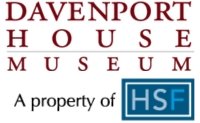Slavery in Savannah | We Know Their Names
We Know Their Names:
How Artifacts and Objects Help us Understand the Human Experience of Being
Between 1812 and 1828 there were as many as 13 enslaved persons who occupied and held a range of responsibilities at the Davenport House. Below are five interactive journeys where you will learn about the lives of several of the persons held in bondage in the Davenport House. Click on either a family or an individual to explore how research has led us to knowing their names. See how historical documents shed light on their lives, families, hopes, and likely household responsibilities. Much of the enslaved experience has not yet been well documented. Piecing together what we know is a powerful step towards more fully acknowledging the legacy and contributions, as well as the hardships and suffering of enslaved Africans in the port City of Savannah.
Experience Their Stories
How We Found Out About The Enslaved Individuals in the Davenport House
Kelly Westfield’s research into the lives of the enslaved members of the Davenport household allows the museum to more fully interpret the lives of these men, women, and children in individualized and meaningful ways. Too often, interpretations of the enslaved in the American South represent generic experiences or focus heavily upon bondage and brutality. What has resulted is a widespread tendency of public interpretation that fails to illustrate individuality and personal experiences. The Davenport House provides an interpretation that emphasizes numerous themes of the enslaved experience, as well as geography and mobility.
-
Ms. Westfield began by conducting reverse deed research at the Chatham County Court House to trace the origins and rebuild the lives of the enslaved members of the Davenport House prior to coming into the home. The deed records provided leads for several other sources of information, such as estate records and wills. This allowed for a timeline and story to be constructed for each person, as well as a better understanding of each individual’s unique geographic footprint.
Once Ms. Westfield learned about individual owners from deed records, she researched their landholdings, occupations, and the locations where they lived. This enabled her to pinpoint the geography of the enslaved persons owned by the Davenports. Information about previous owners and locations provides information about living conditions and other relevant information. These sources also revealed information about family members, and the subsequent generations of enslaved children owned by the Davenports. In the next stage of research, the geographic footprint for each person may indicate place-based experiences, neighbors, or other everyday experiences deriving from location. In essence, Ms. Westfield conducted research of all primary sources; and, traced down every possible lead that would tell her more about the experiences of the enslaved persons at the Davenport House.
The Deed and Probate Records Offices at the Chatham County Courthouse were very critical and very traditional repositories for information. Primary source documents were pertinent to this research, and included deed and estate records, wills, and historic Savannah newspapers. Runaway notices about the enslaved were also extremely important. The Laurel Grove South Internment and Jail Register Records at the City of Savannah Research Library and Municipal Archives were some of the resources unique to Savannah that were consulted for this history.
Ms. Westfield’s research into the lives of each enslaved individual was structured into several categories. The initial section for each person traces her/his origins and life up until their entry into the Davenport House. The next section focuses on locations where each person lived, who their owners were, family members, and other relevant information. This also involved creating maps for each individual - tracing their geographic footprint through time. The final step was to summarize the findings and create concise interpretations for Davenport docents based on the feedback from those involved in the project and other revisions.
Although the Davenport House staff has done a tremendous job collecting historical data on the enslaved members of the household, Ms. Westfield’s research provides new information about each person and emphasizes specific themes that can be incorporated into museum interpretation. It is also the first time that a geographic footprint for each individual has been created. The general knowledge is changed because it is no longer general. Individual stories can now be told, and we know more of their names.
The first person storytelling is based on the research that we do know about the individuals and what is known from research on enslavement in Savannah. A summary of what we know that has not been fictionalized can be found in the third person accounts.





